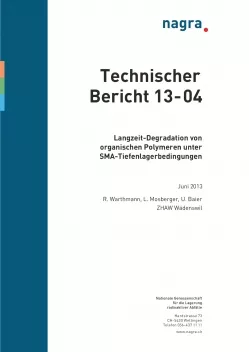
Technischer Bericht NTB 13-04
Langzeit-Degradation von organischen Polymeren unter SMA-Tiefenlagerbedingungen
On behalf of Nagra, the Environmental Biotechnology Section of the Zürich University of Applied Sciences in Wädenswil investigated the potential for microbiological degradation of organic polymers under the conditions found in a deep geological repository for low- and intermediate-level waste (L/ILW). The existing scientific literature on the topic was analysed, some thermodynamic calculations carried out and input was elicited from internationally recognised experts in the field. The study was restricted to a few substances which, in terms of mass, are most significant in the Swiss L/ILW inventory; these are polystyrene (PS), polyvinyl chloride (PVC), other plastics and bitumen.
There were no clear indications in the literature that the polymer structure of synthetic polymers is biodegraded under anoxic conditions. However, functional groups of ion exchangers and plasticizers in plastics are considered to be readily available and biodegradable. The greatest obstacle to biological degradation of synthetic polymers is depolymerisation to produce labile monomers. As energy is generally required for such breakdown, the chances of this process taking place outside the cells are very low. In so far as they are present, monomers are, in principle, anaerobically biodegradable.
Thermodynamic considerations indicate that degradation of synthetic polymers under repository conditions is theoretically possible. However, the degradation of polystyrene is very close to thermodynamic equilibrium and the usable energy for microorganisms would barely be sufficient. Under high H2 partial pressures, it is predicted that there will be a thermodynamic inhibition of anaerobic degradation, as certain interim steps in degradation are endergonic.
The starting conditions for microbial growth in a deep repository are unfavourable in terms of availability of water and prevailing pH values. Practically no known microorganisms can tolerate the combination of these conditions; most known microorganisms require liquid water and a moderate pH (4 – 10). However, these conditions could change over long time periods; microbial activity and growth are certainly possible after repository re-saturation. A slow migration of microbial life from niches where favourable conditions prevail is conceivable.
Almost all the experts questioned were of the opinion that microbial degradation of PS and PVC under anaerobic conditions with limited water supply and high pH conditions can be considered as extremely unlikely over the time period being considered (104 years). They also confirmed that the scientific data available at present are insufficient to allow reliable statements to be made on the degradation of organics under repository conditions.
